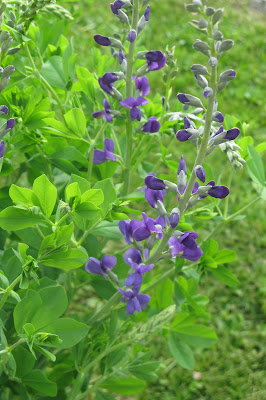












Iris – the word alone conjures up visions of brilliant spring flowers.
This large genus of about 200 species is native in the North Temperate regions of the world.
Iris have orchid-like flowers. 9 to 12 buds are usually found growing on short side branches on each stem. Each blossom lasts about three days.
Principle Iris colors are lavender, blue, white, purple, rose-red, pink, brown or various combinations and blends of these colors.
The two major requirements for successfully growing all classes of bearded iris are full sun and good drainage.
It is important to dig and divide every three to four years under ordinary culture.


The blue false indigo, Baptisia australis, has been one of the most reliable and beautiful herbaceous perennials of them all. The leaves are unique and handsome, the flowers are purplish blue with a touch of gray, and the seed pods, at maturity are jet black and can be used in flower arrangements.
A native of the south central and eastern United States, this plant will grow in zones 3 – 9 However, it prefers fill sun and moist, rich soil. The blue false indigo plant features indigo colored flowers that in form resemble the lupine and annual sweet pea, but are not fragrant.
Additionally, the plants attract bumblebees and the seeds will feed the birds in winter. The Baptisia is deep rooted, long lived, slow growing, and will never invade the garden. The foliage is remarkably pest free and disease resistant.
Plant it all by itself in the garden so its special appeal can best be appreciated.
I have this one planted in the center of the lawn in the front garden. Passersby often stop to admire it and ask me what is it's name.

Chives (Allium schoenoprasum) are the smallest species of the onion family.
The Ancient Chinese have used chives for thousands of years, and it is reported that Marco Polo brought them to Europe from China.
An herb is a plant whose leaves, seeds, or flowers are used for flavoring food or in medicine. Referred to in the plural, as chives. Culinary uses for chives involve shredding its leaves (straws) for use as condiment for fish, potatoes and soups. It has insect-repelling properties, which can be used, in gardens to control pests.
The mauve colored flowers are also edible.
Chives are hardy perennials, they prefer sun and well-drained soil and require little attention.
A fellow garden lover gave these to me. I have several clumps of them around the garden & I love them because they provide attractive color and require no care whatsoever. You can’t get any better than that!

I have had good results with the Nelly Moser Clematis. It is a flowering vine that can reach as much as 12 feet in length, with off-shoots from the main vine reaching out 3-4 feet. Best displayed on a trellis, arbor, or other climbing fixture, the blooms start in late May and can continue all summer long. Clematis are easy to grow, fast growing, and suitable to USDA hardiness zones 4a to 8b.
Water weekly unless there’s a soaking rain.
If you are fearful or are uncertain about pruning, you can skip it. The purpose of pruning is to neaten up the plant and to encourage new growth. In time, even an unpruned clematis will fill out. This plant is beautiful.
